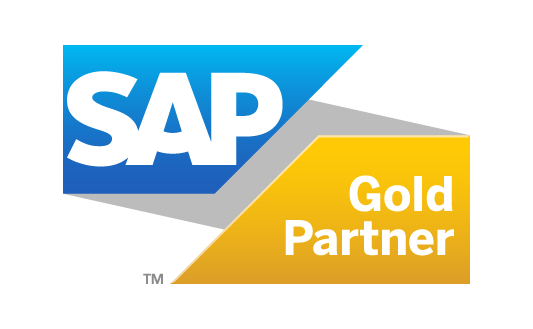The implementation of an SAP S/4HANA solution depends on a large set of strategic parameters. To allow S/4HANA to play to its full strengths, a process comprising Analysis, Design, Planning and Implementation is required. We have developed our own process, building in our experience of strategic SAP implementation projects that stretches back over 40 years.
Simple S/4HANA migration in four steps
The Syntax approach to SAP S/4HANA implementation comprises four steps. If an enterprise has already answered the initial core questions, we can jump straight to step two.

1. Strategic assessment
The first step is to investigate the company’s starting position and its business objectives. We decide which S/4HANA operating model will provide the most benefit and work out the shape of the most suitable migration strategy. This creates the strategic foundation for creating our successful S/4HANA migration.
2. Analysis
Next, we look at the customer’s business processes that are replicated in SAP and decide what can be carried forward and what could be or must be updated. We consider both SAP standard processes and the company’s own developments as a basis for the actual migration plan.
3. Migration planning
The results of the analysis are weighed up and we balance out individual factors. The outcome is the most suitable S/4HANA architecture and a migration plan that reflects the optimum combination of performance, operating cost, business objectives and other aspects.
4. Implementation
Finally, the plans are implemented. In general this means creating the new system in parallel to continuing operations, testing it and then switching over – the big bang! At that point we can fine tune and adapt individual processes as necessary.
Three S/4HANA migration strategies that lead to success
There are three potential migration strategies for moving to S/4HANA. The right one for a given enterprise depends on the implementation scenario, the starting position and its strategic objectives.
A brownfield migration involves moving an existing SAP system into the new S/4HANA environment with as few changes as possible. This method is most suitable if the company’s processes are up to date and future-proof.
Conversely, a greenfield migration is where an entirely new SAP system is created, in terms of both technology and processes. This approach is especially appropriate in cases where the existing systems are old or do not suit the company’s future strategy. It is also the solution for businesses that are not yet running an SAP system, of course. Even if S/4HANA is to run in the cloud, greenfield is the ideal option since existing processes will not generally fit with those of the cloud solution.
A selective data migration approach combines the two strategies. Legacy workloads are discarded, while processes that are known to work are implemented in the new system.
How long should an S/4HANA migration take?
It goes without saying that the length of time to introduce SAP S/4HANA depends on the complexity of the customer’s system and a range of other factors. Our experience in many different projects, however, tells us that typical brownfield S/4HANA system conversions take on average eight months to complete. A fresh start (greenfield) project generally lasts around 11 months. Things move faster when businesses migrate to a S/4HANA cloud solution, since this removes the need to create or expand technical infrastructure. In this case, it is often possible to start working after just three months.
All things considered, the actual implementation often takes the least amount of time. The majority of the effort goes into analysis and planning, and customers are well advised not to cut corners during this stage. That is because the decisions made at this point in the process will be key to the long-term success of the S/4HANA system.
8 questions to choose the right migration strategy
1. Do your current business processes support your long-term strategy?
Introducing new business processes will generally entail a fresh implementation.
2. Can you use SAP standard processes and best practices?
Getting on board with standardisation also makes you more agile – arguments for a fresh start.
3. Who is driving your move to SAP S/4HANA? Business or IT?
IT’s concerns will be primarily about replicating existing processes cleanly in S/4HANA. Business departments are more interested in innovation and new business models. You need to bring both around the table to discuss and clarify objectives and priorities in order to work out the right strategy.
4. Can you move from SAP ERP to SAP S/4HANA in a single step?
A single-step move is possible for SAP 6.x (any enhancement package) single-stack systems using Unicode. If the system cannot be moved in a single step, a fresh implementation is probably the best option.
5. Do you need access to old transactions in the new system?
The migration of historical data is a key indicator that a conversion process will be needed. Alternatively, legacy data can also be migrated to a new hardware platform for a fresh implementation, or stored in a data retention solution.
6. Are the main reasons for moving to consolidate the landscape and harmonise processes?
If so, the best option may be a fresh implementation with consolidation of the necessary configuration and data in a new system.
7. How many interfaces are there between your current ERP system and other systems?
The greater the number of interfaces (between SAP and other providers), the more likely a system move is the right choice.
8. Is your enterprise ready to cope with a multi-year innovation plan?
Companies with defined innovation processes handle system conversions and subsequent innovation projects well. If you are not sure about managing a multi-year innovation plan, only a fresh implementation will give you the innovative drive you need.

FAQ: S/4HANA implementation
Can historical data be migrated to S/4HANA?
Businesses can migrate as much of their existing data as they want to S/4HANA. Primarily this issue is concerned with any data that is subject to specific retention periods and has to be migrated for compliance reasons. The extent to which historical data should make the move to the new application platform and the HANA database will be clarified as part of the strategic planning process. Enterprises should also see their SAP S/4HANA implementation as an opportunity to clean up their system and get rid of unnecessary legacy information. This is especially important for implementation projects that involve a migration to the cloud, where costs will also depend directly on the size of the database.
What is the process for transferring data from the old system to S/4HANA?
There are several standard tools from SAP that can be used to migrate data, as well as various third-party solutions. SAP Software Update Manager 2.0 (SUM2) with the Data Migration Option (DMO) is suitable for a brownfield migration,for example. This lets you bring existing SAP systems into the target S/4HANA architecture without making it complicated. SAP offers the S/4HANA Migration Cockpit to organise and carry out the transfer of data in greenfield projects. However there are other comparable solutions such as that developed by Syntax’ partner Datavard: The Datavard Transformation Suite is perfect for selective data migration and greenfield migrations in the S/4HANA environment.
What is the best S/4HANA migration strategy?
Many enterprises ask about how to switch to SAP S/4HANA. There is no single recipe for introducing the SAP S/4HANA system. Each company must define its own implementation scenario. If current processes support the future strategy, with only a few process modifications required and the company already using the latest pre-S/4HANA version, the signs all point to a brownfield installation. On the other hand, if historical data needs to be migrated, but only a few new business models need to be integrated, from an SAP system that is not up to date, a selective data migration could be the best option. However, if in a similar context there is also a need to introduce a number of new business models, the greenfield approach is the method of choice. Three strategies – all useful and providing value in their own way.